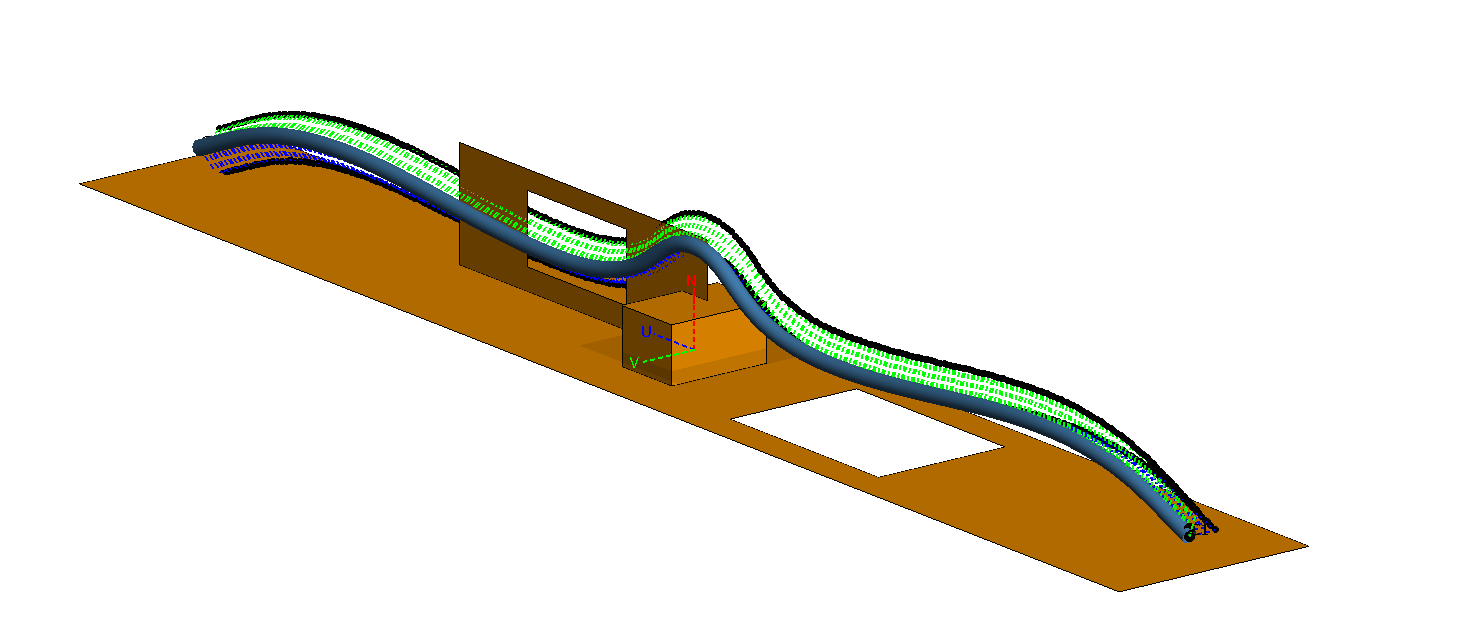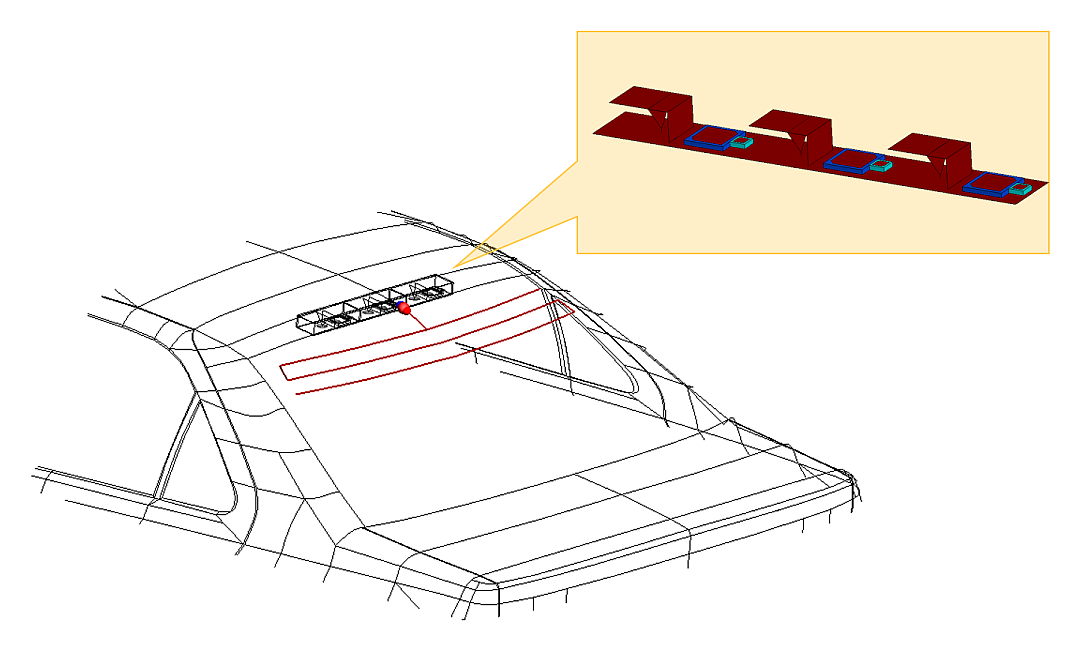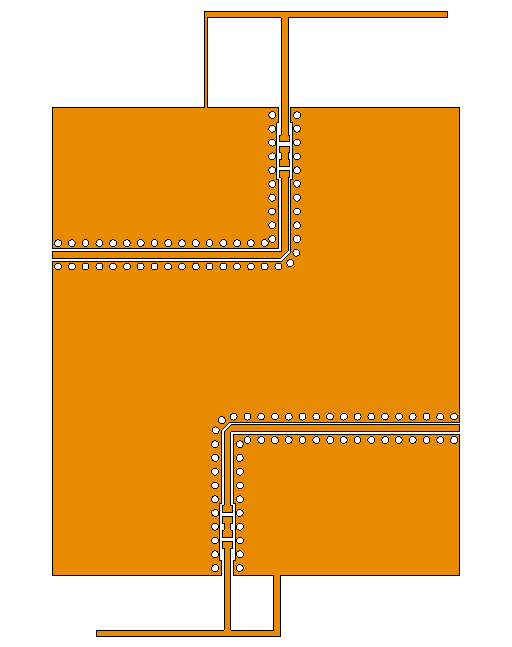Release Notes: Altair Feko 2018.1
Altair Feko 2018.1 is available with new features, corrections and improvements. It can be applied as an upgrade to an existing 2018 installation, or it can be installed without first installing Altair Feko 2018.
Highlights of the 2018.1 release
The most notable extensions and improvements to Feko and WinProp in the 2018.1 release.
Salient Features
- The restrictions for cable height above ground are lifted for differentially driven
cable problems. The user needs to define the orientation of any cable that does not have
nearby geometry by specifying the cable's reference direction.

Figure 1. A preview of the cable cross-section orientation of a cable running above an arbitrary ground installation. - GPU acceleration of flat PEC RL-GO models with manual ray-launching increment settings. Acceleration of up to 40 times faster can be achieved.
- Further memory savings using shared memory technology. The savings are model and solution method dependent with the most prominent savings observed for PO. The PO solution of currents due to a dipole source on a generic aircraft discretised into 1.95 million triangles showed a memory reduction of more than 30% when using 20 cores on a single CPU.
- A new direct ACA solver that is the default for ACA. Memory savings are model dependent with some examples showing up to a 90% reduction in the memory requirement.
- FEM is supported together with MoM/MLFMM windscreen solutions and planar multilayer
substrates. Utilising FEM in parts of a model where it is more applicable than the MoM may
provide substantial memory and runtime improvements. A representative example of an
antenna module in a car with windscreen showed a reduction in memory and runtime of
80%.

Figure 2. Partial view of a car with a windscreen antenna solved with the MoM/MLFMM and an antenna module mounted in the car's roof (shown enlarged in the insert) solved with the FEM. - General improvements to the interface when working with Gerber files and to Gerber file
export. Arbitrary file extensions are supported for Gerber import. Gerber exports are
improved to handle more complex meshed planar geometry.

Figure 3. View of an exported Gerber file of a planar antenna with via holes.
Feko 2018.1 Release Notes
The most notable extensions and improvements to Feko, listed by component.
CADFEKO
Features
- All files (*.*) are now displayed in the file browser when importing geometry and selecting to import a Gerber file. The standard Gerber file extension is .gbr, but in practice, various other extensions are in use. The extensions that were supported in the previous version of CADFEKO (.art, .gbr, .bml, .bot, .bps, .bsk, .gnd, .tmk, .top, .tps and .tsk) are still shown in the file browser with other known CAD model files. Files with extensions like .cmp, .ger, .gbl, .gtl, .sol, and other custom extensions, can be imported by selecting “Gerber” as the file format. These files no longer have to be renamed to a known extension before import. The requirement holds that the files need to be in extended Gerber (RS274X) format.
- The CEM validate check for valid FDTD requests is updated to support a looped plane wave source together with FDTD.
Resolved Issues
- Gerber export now works for meshes of geometry faces that include cut-outs. Exporting to Gerber file did not recognise the cut-outs and for successful export, geometry had to be modified so that there was no hole in any single face.
- Files created in the Feko temporary directory during Gerber and ODB++ import could cause the import to fail if files with the intended temporary file names already existed. The import process now uses temporary folders with unique file names inside the Feko temporary directory. CADFEKO deletes these folders once the import completes or if the user cancels the import.
- Resolved a crash that could occur when applying changes to a huge model.
- Corrected the macro recording of actions performed on a primitive part inside a union to reference the parent union.
- Resolved an assertion failure with message ending in “m_dataOperatorMap.contains(pData.get())”. This assertion could fail in CADFEKO 2018.0.2 when modifying a port in a model where meshes containing ports were previously merged and undo/redo operations were applied.
- Improved the meshing of some spiral structures to mesh more accurately around the centre of the spiral.
- Corrected the optimisation goal dialogs to list only valid operations when modifying optimisation goals. For example, the Modify impedance goal dialog incorrectly included the option to use “dB”.
- Changed the behaviour when importing points from a text file to skip empty lines instead of only reading up to the first blank line. An assertion failed in “ImportCsvDriver.cpp” when trying to import points from a text file starting with an empty line.
- Fixed an assertion failure in “common_SchematicNet.cpp” that could occur when importing a .cfx file containing connected schematic elements. This assertion failure could also occur when deleting a connection between rotated schematic elements, saving the model and selecting to undo past the point of saving.
- Opening the properties of a single mesh label and applying without changes resulted in the removal of the simulation mesh, the display of the message Setting mesh label properties in the message window and a comment recorded during macro recording. Applying no modification to a single mesh entity no longer removes the mesh or prints out these messages. Simultaneously applying no changes to the properties of more than one mesh entity with clashing settings still deletes the mesh and reapplies the settings.
EDITFEKO
Features
- Added the SD card for defining cable shield layers. The SD card definitions are used in an SH card when creating a single or double shield. The existing Solid (Schelkunoff), Braided (Kley) and Braided (Vance) definitions are available on the SD card. New Tyni and Demoulin formulations are available, or the shield transfer capacitance can be specified.
- Changed the SH card to support single and double cable shields using SD card shield definitions.
- Extended the method to define cable shield properties on the SD card (previously found on the SH card) to specify interpolation methods and extended the surface impedance options to define data points manually or to use a low-frequency braid approximation.
POSTFEKO
Resolved Issues
- Fixed a crash that could occur when exporting tables containing datasets to .mat file and improved validation to prevent the export of invalid or unsupported data types.
- Improved the adaptive frequency sampling for POSTFEKO frequency to time domain conversion.
- Corrected the normalisation and improved validation for Touchstone exports. Y-parameters and Z-parameters are normalised correctly. Newly introduced validation prevents the export of Y-parameters and Z-parameters when the reference impedance is unknown, or if ports have incompatible reference impedances. Results are not normalised when exporting S-parameters for ports without reference impedances, such as FEM modal ports.
- Changed the way the 3D view legend handles individual ranges and rounding to prevent the misinterpretation of results. When a dynamic range is specified, and legend rounding is switched on, going forward, the legend may use a range exceeding the specified range. The display now remains unchanged when changing from the “Specify dynamic range” setting to a “Fixed range” and entering the legend settings displayed in the 3D view for the “Specify dynamic range” option.
- Fixed cursor table column spacing and improved the accuracy of displayed values.
Solver
Features
- Support GPU acceleration for flat PEC RL-GO models with manual ray-launching increment settings.
- Reduced memory usage for MoM, MLFMM, PO and LE-PO problems run in parallel where some processes share a node (shared memory).
- Support waveguide ports on MoM regions for the uncoupled MoM/RL-GO hybrid method.
- Support elliptically polarised plane wave source for the RL-GO solution method.
- Cable height above ground restrictions are lifted for differentially driven cable problems.
- Support surface impedance and different frequency ranges for transfer impedance, surface impedance and transfer admittance in cable shield definitions imported from .xml file.
- Support cable shields defined by transfer capacitance.
- Support different interpolation methods for cable shield impedance and admittance data.
- Support manually specified cable shield surface impedance.
- Support a low-frequency braid approximation for cable shield surface impedance.
- Support modelling double shielded cables directly.
- Support Tyni and Demoulin formulations for transfer and surface impedance and transfer admittance in cable shield modelling.
- Support the sequential direct LU decomposition solution technique for ACA.
- Select the direct solver for ACA problems by default. Previously the iterative solver was used.
- Support monostatic RCS calculation in a loop for the FDTD.
- Support FEM together with MoM/MLFMM windscreen solutions and planar multilayer substrates.
Resolved Issues
- Bypassed a bug in a maths library used on AVX-512 systems that caused a floating point exception during the iterative solution phase of the MLFMM.
- Significant performance improvement for MoM PBC matrix fill.
- Improved the robustness of the solution of MoM PBC problems when the direction of incidence is at theta=90.
- Improved the robustness for RL-GO curvilinear triangle ray intersection tests.
- Improved RL-GO low accuracy results for incident waves close to grazing incidence.
- Improved automatic convergence for adaptive ray-launching for RL-GO.
- Fixed a cable meshing bug that caused small features to be distorted.
- Avoid internal error 38719 by improving the calculation of surface impedance for braided cable shields.
- Fixed a bug that caused sporadic Intel MPI Hydra errors on parallel Windows systems.
- Fixed an internal error state when calculating the far fields with UTD due to a spherical mode source defined with a very large number of modes.
- Fixed a bug that caused in internal error state when printing out RL-GO ray statistics when there are zero rays generated.
- Improved error checking for problems where TR coefficients are extracted with an RL-GO surface together with the multilayer substrate formulation.
- Improved the Touchstone file import correctness check for reference impedance values set to zero.
- Improved error messages that occur during cable shield braid setup.
- Added geometry intersection tests for cable paths and wire segments with planar triangles.
- Fixed a bug that caused the electric charge distribution to be unsymmetrical for FEM problems where an electrical plane of symmetry is used.
Support Components
Features
- Improved error messages when importing external Feko data files such as .tr, .ffe, .efe and .hfe (PREFEKO).
Resolved Issues
- Fixed a bug that reported the runtime incorrectly for continuous frequency solutions (ADAPTFEKO).
- Added firewall exceptions for the MPI Hydra service to the installation process when running it as an administrator.
- Changed the console mode installation to have automatic updates turned on by default.
- Added an example to the Feko Examples Guide that demonstrates the use of the characterised surfaces feature with RL-GO for efficiently solving a frequency selective surface.
WinProp 2018.1 Release Notes
The most notable extensions and improvements to WinProp, listed by component.
ProMan
Features
- Added the ability to compute and present a new class of results, elevation angles and spreads, in addition to the already existing azimuth angles and spreads.
- When viewing field or power results, ProMan will, from now on, ask only once per session whether to load available ray paths.
Resolved Issues
- Fixed a bug that could lead to different results for received power in RunMS depending on whether a channel matrix entry is selected as output or not.
- Fixed a bug in the superpositions of ray contributions in the received-power calculation (RunMS).
- Fixed a bug where, in “PostProcessing incl. Tx and Rx”, the transmitter antenna pattern was not considered.
- Fixed a bug in the power superposition for rays in Standard Ray Tracing with Fresnel/UTD coefficients.
- Fixed a bug that prevented the channel condition number from being computed in the previous update, 2018.0.2.
- Fixed a bug that, on some systems, caused the 3D button that toggles the 3D display to be greyed out in rural scenarios.
Application Programming Interface
Resolved Issues
- Added capabilities to the WinProp API for handling vegetation and clutter in outdoor scenarios. In doing so, backward capability for outdoor clutter in the API could not always be maintained.